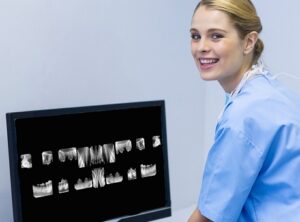Dental Radiography & The Diagnostic Process: The Technician ‘Key’

As technicians we take radiographs all the time. It is a skill that we take for granted in many respects. We go and take the radiograph and forget all the skills and knowledge we had to acquire to achieve a diagnostic image. We must have a good understanding of anatomy, radiography principles & theory, and how to use the equipment properly. There is still a part of me that feels I have won the lottery when I see the ‘perfect’ image.
Before we show our doctors the image we took, most technicians, myself included, assess the radiograph, and make sure we think it is ‘diagnostic’. We are not diagnosticians, but we must be able to decide if an image needs to be taken again.
All these things apply to dental radiography, not just conventional radiography. We must remember that periodontal disease cannot be accurately diagnosed and staged without radiographs. As technicians, we must know what constitutes a diagnostic image, how to troubleshoot common positioning errors, and understand periodontal disease stages. In this article we are going to look at each of these things in a bit more detail.
The Perfect Image
I struggle with perfect, especially in the world of dental radiography. Dental radiographs are hard because we are working with challenging angles in a very small space. That naturally creates issues that we do not see in conventional radiography. When you start with dental radiography, be kind to yourself! Instead of trying for perfection, aim to get what we need for diagnostics. These are, in my opinion, criteria that need to be met in most general practice environments.
When assessing a dental radiograph, we need to see the apex of the root, inclusive of some of the root itself, and 3 – 5 mm of surrounding alveolar bone. We do not need the crown of the tooth. In many radiographs you will get the crown and that is great but if you must cut off the crown to get the root (common with large teeth) that is acceptable.
If you see these things on a radiograph, that image is acceptable for diagnostics provided the doctor you are working with can see what they
need. If you do not see those things, immediately retake the image. Do not waste any time debating about the image. You are good!
Troubleshooting
You are going to have to retake dental images. You are going to have to retake them a lot more than you do conventional radiography. This
is reality especially when you start with this imaging.
Fortunately, many of the issues we see are quite common so the ‘fixes’ are fairly well known. You will become more comfortable with troubleshooting with time and practice. Having a solid understanding of the basics of dental radiography is the most important way in which we can reduce the amount of troubleshooting you do. There have been past articles and webinars delivered with Heska on this material. Please access them!
Let’s talk about troubleshooting some of the more common issues we see.
Root Elongation
Root elongation is a common error resulting in the image of the root being distorted and appearing longer than it is.
What is this caused by? Everything could be okay here in terms of patient positioning and plate positioning. This error really comes down to the angle of the beam. Bisecting angle is a challenge. In this case, the beam is too low on the tooth producing a ‘shadow’ (image) that is long. Why is this problematic versus when is it necessary? If the roots are elongated enough, it makes an image non-diagnostic. It is non-representative of how the tooth is positioned in the mouth and makes the periodontal ligament challenging to properly assess.
One important thing to note with this error, the one-time root elongation may be necessary is when taking a radiograph of the maxillary
premolars and molar in cats. Either tube shifting techniques, or an extra-oral technique will eliminate the zygomatic arch superimposition
often seen in cats.
Fixing an image with elongated roots is straight forward.
Think of the bisecting angle – remember as the beam gets lower and lower a shadow casted becomes longer and longer. Re-evaluate the bisecting angle. Use cotton-tipped applicators on tongue depressors to visualize and confirm the x-ray tube positioning, then use the numbers on the x-ray tube head (angle of tube) to make sure you are approximately on the right track (most images should be approximately 45 – 50 degrees).
Make sure you are aiming at the root while you adjust your angle.
Root Foreshortening
Root foreshortening is another common issue seen in dental radiography.
The root appears short or appears to have less depth than normal. Like root elongation, some minor root foreshortening is not too much of a problem but if it is significant, it is not representative of how the tooth is positioned, the periodontal ligament space is very difficult to evaluate, so the image is therefore non – diagnostic.
What is this caused by? Like root elongation, everything could be fine here with patient positioning and plate placement. Again, the angle of the beam is usually the culprit. In this case, the beam is too high resulting in an image that looks short and wide.
Is this sometimes necessary like root elongation?
The short answer to this is no. It does not have any positioning benefits like minor root elongation can.
Fixing root foreshortening is also straight forward.
Again, think of the beam. When the beam is too high (think high noon) an object will hardly cast any ‘shadow’.
Re-evaluate the bisecting angle technique. Use cotton – tipped applicators so you can visualize the angle. The tube needs to come lower. Use
numbers again to confirm (45 – 50 degrees respectively) and confirm plate placement. Make sure you continue to aim at the tooth root.
Cone Cut
Cone cut is another common issue in dental radiography.
What is it? When people start with dental radiography the tendency is to aim the beam at the crown of the tooth. This results in the apex of
the root not being visualized on the radiograph. This is called cone cut. You will see a circle shape on the film with white. This is indicating the area where there was no exposure.
How do we fix cone cut? Your bisecting angle could be completely correct, and you still have cone cut so make sure to evaluate it as both situations occur independent of the other. If your bisecting angle looks okay, then simply move the beam over in the direction of the cone
cut (toward the white on the radiograph).
Once you have moved the beam, double check your bisecting angle and make sure that has not changed too much. Make sure to double check your plate placement.
There is nothing more frustrating than retaking an image and realizing your plate has shifted after you took the image.
Not dissimilar to cone cut is cutting off the target at the end of the film or sensor. This happens most frequently when the sensor moves and is not checked right before exposure. The other situation where I see this is in dogs when the plate is not shifted far back enough to get the
maxillary molars.
Again, the fix is straight forward, simply move the sensor to the area you cut off.
The Elusive Root Apex
I can’t get the root apex! This is a common concern.
Remember the tooth we see is only one third of what is there.
How This Relates to Periodontal Disease
As I mentioned at the start, as technicians we must know how to determine if an image is diagnostic, not because we are diagnosing, but to accelerate the diagnosis process. Veterinarians require an accurate patient database to diagnose and then decide on a treatment plan.
Technicians and our skills are a critical part of that process. Why do diagnostic dental radiographs matter? What are veterinarians assessing in these radiographs?
Let’s briefly look at periodontal disease staging so we have a better grasp of what criteria are being evaluated.
The Stages Explained
Here is what is expected at each stage.
| Stage 1 | Gingivitis (the inflammation of the gingival tissue), some tartar likely to be seen. This stage is reversible. |
| Stage 2 | Pocket depth is greater than 5 mm in dogs or greater than 1 mm in cats. Up to 25% attachment loss. |
| Stage 3 | Pocket depth is now greater than 9 mm in dogs and 1.5 mm in cats. There is 50% attachment loss. |
| Stage 4 | Pocket depth is now greater than 9 mm in dogs and greater than 2 mm in cats. There is over 50% attachment loss. |
When the veterinarians look at these images, they are assessing these things to properly diagnose and stage the disease and then decide
on a treatment plan.
Without these radiographs, a proper diagnosis simply cannot be achieved. Every COHAT (Comprehensive Oral Health Assessment &
Treatment) should have full mouth radiographs.
It is simply good medicine. No more than a yeast infection in an ear should be diagnosed without a swab, should periodontal disease be diagnosed without radiographs!
The Technician’s Role
Our role is to understand what is happening with periodontal disease, understand what constitutes a diagnostic image, and then understand how to achieve a diagnostic image including the processes of troubleshooting.
A technician is a key part of the diagnostic process. The information we collect and tasks we perform are necessary for the proper care of our
patients.
We must remember to keep our skills sharp and continue to grow our knowledge through continuing education. We are such an important
part of the diagnostic team! For me, having that ‘winning the lottery’ feeling after taking a ‘perfect’ image and knowing I was key in helping my patient is what keeps me coming back day after day!

